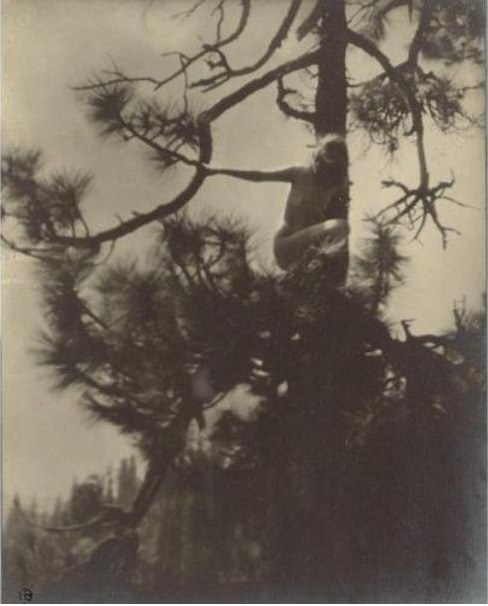
Anne Wardrope (Nott) Brigman (1869 - 1950) was an American photographer and one of the original members of the Photo-Secession movement in America. Her most famous images were taken between 1900 and 1920, and depict nude women in primordial, naturalistic contexts.
Brigman was born in the Nuuanu Valley above Honolulu, Hawaii on 3 December 1869. She was the oldest of eight children born to Mary Ellen Andrews Nott, whose parents has moved to Hawaii as missionaries in 1828. Her father, Samuel Nott, was from Gloucester, England. When she was sixteen her family moved to Los Gatos,California, and nothing is known about why they moved or what they did after arriving in California. In 1894 she married a sea captain, Martin Brigman. She accompanied her husband on several voyages to the South Seas, returning to Hawaii at least once.
Imogen Cunningham recounts a story supposedly told to her firsthand that on one of the voyages Brigman fell and injured herself so badly that one breast was removed.[1] Whether this is true or not, after 1900 she stopped traveling with her husband and became active in the growing bohemian community of the San Francisco Bay area. She was close friends with the writer Jack London and the poet and naturalist Charles Keeler. Perhaps seeking her own artistic outlet, she began photographing in 1901. Soon she was exhibiting in local photographic salons, and within two years she had developed a reputation as a master of pictorial photography. In late 1902 she came across a copy of Camera Work and was captivated by the images and the writings of Alfred Stieglitz. She wrote Stieglitz praising him for the journal, and Stieglitz in turn soon became captivated with Brigman's photography. In 1902 he listed her as an official member of the Photo-Secession, which, because of Stieglitz's notoriously high standards and because of her distance from the other members in New York, is a significant indicator of her artistic status. IN 1906 she was listed as a Fellow of the Photo-Secession, the only photographer west of the Mississippi to be so honored.[2]
From 1903 to 1908 Stieglitz exhibited Brigman's photos many times, and her photos were printed in three issues of Stieglitz's journal Camera Work. During this same period he often exhibited and corresponded under the name "Annie Brigman", but in 1911 she dropped the "i" and was known from then on as "Anne". Although she was well known for her artistic work, she did not do any commercial or portrait work like some of her comptemporaries. In 1910 she and her husband separated, and she moved into a house with her mother. By 1913 she was living alone "in a tiny cabin...with a red dog...and 12 tame birds".[1] She continued to exhibit for many years and was included in the landmark International Exhibition at the Albright-Knox Art Gallery in New York in 1911 and the Internation Exhibition of Pictorial Photography in San Francisco in 1922.
In California, she became revered by West Coast photographers and her photography influenced many of her contemporaries. Here, she was also known as an actress in local plays [1], and as a poet performing both her own work and more popular pieces such as Enoch Arden [2]. An admirer of the work of George Wharton James, she photographed him on at least one occasion [3].
She continued photography through the 1940s, and her work evolved from a pure pictorial style to more of a straight photography approach, although she never really abandoned her original vision. Her later close-up photos of sandy beaches and vegetation are fascinating abstractions in black-and-white. In the mid-1930s she also began taking creative writing classes, and soon she was writing poetry. Encouraged by her writing instructor, she put together a book of her poems and photographs call Songs of a Pagan. She found a publisher for the book in 1941, but because of World War II the book was not printed until 1949, one year before she died. Brigman died on 8 February 1950 at her sister's home in El Monte, California.
Brigman's photographs frequently focused on the female nude, dramatically situated in natural landscapes or trees. Many of her photos were taken in the Sierra Nevada Mountains in carefully selected locations and featuring elaborately staged poses. Brigman often featured herself as the subject of her images. After shooting the photographs, she would extensively touch up the negatives with paints, pencil, or superimposition.
Brigman's deliberately counter-cultural images suggested bohemianism and female liberation. Her work challenged the establishment's cultural norms and defied convention, instead embracing pagan antiquity. The raw emotional intensity and barbaric strength of her photos contrasted with the carefully calculated and composed images of Stieglitz and other modern photographers.
via Wikipedia, image via Turn of the Century

No comments:
Post a Comment